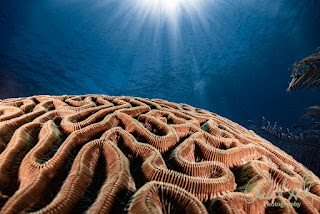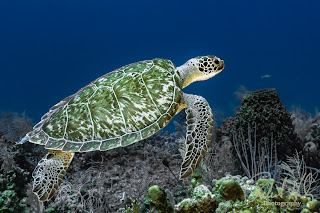Comparing Mirrorless and DSLR Cameras for Underwater Photograph: An In-Depth Guide
Example of size difference between the two types
I often get asked what kind of camera I use and why I currently use a mirrorless camera instead of a DSLR. Let me first state that in my +45 years of shooting underwater photos, and the vast improvements in post-processing over the years, the choice comes down to your specific type of photography (wide-angle, macro, wrecks, caves, etc.) budget, how much travel you do, and your preference.
I have recently told my clients and friends that if I chose a new camera today, I would probably go with an Olympus TG-6 with strobes, and video light, due to size, capabilities, costs, and versatility. Most of my reasoning behind this decision is that post-processing has advanced so far in the last couple of years, that the camera is no longer the primary reason for outstanding photographs, post-processing is the dominant driver. AI features in post-processing now allow you to take just about any RAW image and take it to a work of art.
This is my opinion, but remember I started my underwater photography journey in the 70s with Nikonos cameras and slide film, processing in a dark room, dogging and burning using paddles under a light source, during development.
But to be fair, I wanted to write this blog pointing out some key differences between mirrorless and DSLR cameras. So let's take a look at some of these differences.
Choosing between mirrorless and DSLR cameras for underwater
photography can be challenging. Both have unique strengths and
weaknesses. Understanding these can help you make the best decision for
your underwater photography needs. Let’s dive deep into the specifics.
1. Size and Weight
Mirrorless Cameras:
- Pros:
Known for being more compact and lighter, mirrorless cameras are easier to
handle and travel with, especially on dive trips where every ounce counts.
- Cons:
The reduced size sometimes results in fewer or smaller physical controls, which can
be less convenient when operating the camera with diving gloves.
DSLR Cameras:
- Pros:
Typically larger and heavier, offering better stability underwater,
particularly with large lenses. This can be beneficial for maintaining
steady shots in currents or when using longer lenses.
- Cons:
The bulk and weight make them more cumbersome to carry and handle,
potentially leading to fatigue on longer dives.
2. Autofocus Performance
Mirrorless Cameras:
- Pros:
Advanced autofocus systems with numerous focus points, including features
like eye-detection and subject-tracking, excel in capturing fast-moving
marine life. Continuous autofocus is often more reliable due to recent
technological advancements.
- Cons:
In low light or low-contrast underwater conditions, mirrorless autofocus
can sometimes struggle, although newer models are improving rapidly.
DSLR Cameras:
- Pros:
Traditionally known for superior autofocus performance, especially in
challenging lighting conditions. Optical viewfinders provide real-time,
lag-free feedback, making it easier to capture spontaneous moments.
- Cons:
The number of autofocus points is generally lower than in mirrorless
systems, and live-view autofocus can be slower.
3. Battery Life
Mirrorless Cameras:
- Pros:
Battery technology is improving, but mirrorless cameras typically
offer shorter battery life due to electronic viewfinders and constant
screen use. Most newer mirrorless cameras come with dual battery compartments to compensate for this.
- Cons:
Additional batteries are often necessary, particularly for extended
underwater shoots.
DSLR Cameras:
- Pros:
Longer battery life, thanks to the optical viewfinder that doesn’t require
power, making them more reliable for lengthy dives.
- Cons:
Fewer battery-related interruptions, allowing you to focus on capturing
your underwater subjects.
4. Lens Selection
Mirrorless Cameras:
- Pros:
Increasingly diverse lens options, with manufacturers continuously
expanding their offerings to include high-quality lenses suitable for
underwater use.
- Cons:
While the selection is growing, some specialized lenses are still more
common in DSLR systems.
DSLR Cameras:
- Pros: An extensive range of lenses, including many third-party options, provides greater flexibility in underwater photography.
- Cons: The emphasis on developing mirrorless cameras means that some new lenses may not be available for DSLRs.
5. Viewfinders
Mirrorless Cameras:
- Pros:
Electronic viewfinders (EVFs) provide real-time previews of exposure and
white balance, which can be very helpful underwater.
- Cons:
EVFs can experience lag and may not perform as well in very bright or very
dark conditions.
DSLR Cameras:
- Pros:
Optical viewfinders (OVFs) provide a direct, lag-free view of the scene,
making it easier to frame shots intuitively.
- Cons:
OVFs don’t show exposure or white balance adjustments in real time.
6. Durability and Build Quality
Mirrorless Cameras:
- Pros:
Many models feature robust weather sealing and durable construction,
suitable for underwater housing.
- Cons:
Generally, mirrorless cameras are not as rugged as DSLRs, but high-end
models are closing the gap.
DSLR Cameras:
- Pros:
Known for their durability and robust build, making them well-suited for
underwater housing and rough conditions.
- Cons:
The added durability contributes to increased weight and bulk.
7. Price and Investment
Mirrorless Cameras:
- Pros:
Often more affordable initially, with ongoing advancements offering
cutting-edge technology at competitive prices.
- Cons:
Costs can add up with accessories and lenses, especially if transitioning
from a DSLR system.
DSLR Cameras:
- Pros:
Established systems with a wide range of affordable lenses and
accessories. Upgrading within a DSLR system can be more cost-effective if
you already own compatible gear.
- Cons:
As manufacturers shift focus to mirrorless, newer DSLRs are becoming less
common, potentially limiting future upgrades.
8. Ease of Use Underwater
Mirrorless Cameras:
- Pros:
Lightweight and compact design makes them easier to handle in underwater
housings. The ability to see exposure changes in real-time with the EVF is
a significant advantage.
- Cons:
Fewer physical buttons can make adjustments harder with gloves.
DSLR Cameras:
- Pros:
The ergonomic design and physical buttons are easier to use with gloves,
and their weight helps with stability underwater.
- Cons:
Bulkier size can make it harder to maneuver in tight spaces.
Conclusion
Both mirrorless and DSLR cameras have unique
advantages and disadvantages for underwater photography. Mirrorless cameras
offer advanced autofocus, real-time exposure previews, and a more compact
design, making them great for traveling and maneuverability. On the other hand,
DSLRs provide robust build quality, longer battery life, and superior handling
with gloves, making them reliable for extended underwater sessions.
When choosing between the two, consider your specific needs, such as the types of subjects you shoot, your diving conditions, and your budget. Ultimately, both systems can produce stunning underwater images, so the best choice is the one that fits your style and workflow.
Stay Connected
Follow my blog for more tips and tutorials on underwater photography. Let's dive deeper into the art and craft of capturing the marine world!
Subscribe to my blog for more tips and tutorials on underwater photography. Don’t forget to share your processed photos on social media using the hashtag #RobertHerbPhotography. I look forward to reviewing your results.
New Online Training Program
I am excited to announce that I am creating an online training program to teach underwater hobbyists and enthusiasts how to enhance their photos using Adobe Lightroom. If you are interested in this training, please contact me at bob@robertherb.com to express your interest and to be notified about the details and start date of the classes.
Stay tuned and "Follow" for upcoming blogs on underwater photography tips and tricks for more in-depth insights. Please leave your comments and suggestions. Enjoy your diving and shooting experience!
I am eagerly anticipating your valuable feedback and suggestions.
Sincerely,
Bob Herb
|
|






Comments
Post a Comment
Please let me know your comments.